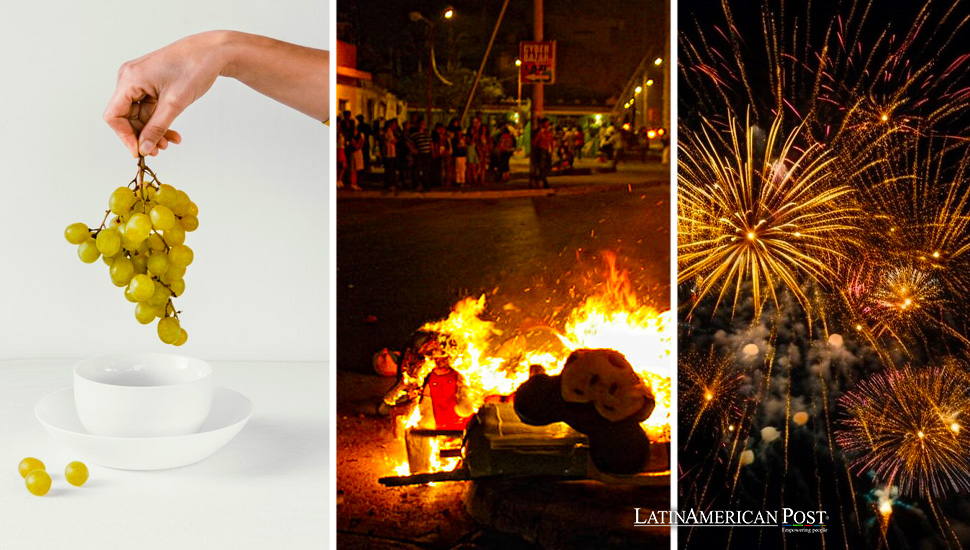New Year’s Traditions in Latin America Show Tapestry of Cultural Celebrations

From the iconic fireworks of Rio de Janeiro to the ancestral rituals of the Andes, the region’s diverse populations showcase their rich cultural heritage and exuberance during this momentous occasion. Let’s embark on a journey through Latin America to explore the captivating ways in which its people celebrate the arrival of the New Year.
Welcoming the New Year in Mexico: A Grape-Filled Tradition
It’s all about ringing in the New Year with good luck in Mexico. A cherished tradition involves consuming twelve grapes at the stroke of midnight, each grape symbolizing a wish for the upcoming months. Additionally, many Mexicans believe wearing red undergarments on New Year’s Eve will attract love and passion in the coming year.
Brazil’s world-famous Copacabana Beach in Rio de Janeiro transforms into a dazzling sea of colors on New Year’s Eve. Millions gather to witness a jaw-dropping fireworks display that lights up the sky. At the same time, revelers dress in all white, symbolizing purity and peace.
High in the Peruvian Andes, indigenous communities observe the New Year with ancient rituals that pay homage to Pachamama, the Earth Goddess. Coca leaves, grains, and other gifts are offered to the Earth, while bonfires are lit to cleanse and renew the spirit.
Ecuador’s Fiery Farewell: Burning the “Años Viejos”
Ecuadorians have a unique tradition of crafting giant effigies called “años viejos,” representing the old year. These effigies are stuffed with old clothes, newspapers, and firecrackers. They are then set ablaze at midnight, symbolizing the purging of the past year’s negativity.
In Colombia, it’s believed that taking an empty suitcase for a walk around the block at midnight will ensure travel opportunities in the coming year. Families also partake in the tradition of walking in circles around the house with their empty luggage in tow, hoping for exciting journeys ahead.
While champagne is famous for New Year toasts worldwide, Argentina has its own twist. It’s customary to clink glasses with cider here, offering a sweet and refreshing start to the year.
Venezuela’s Yellow Underwear Tradition: Ushering in Prosperity
Like Mexico’s use of colored undergarments for luck, Venezuelans don yellow underwear on New Year’s Eve to usher in prosperity and wealth for the upcoming year.
Valparaíso, Chile’s coastal gem, hosts one of Latin America’s most renowned New Year’s fireworks displays. The city’s hills and harbor come alive with bursts of color, captivating the hearts of both locals and tourists.
In Puerto Rico, many islanders celebrate by taking a midnight dip in the ocean. This symbolic cleansing ritual is believed to wash away the past and welcome the new year with a fresh start.
Guatemalans partake in a unique New Year’s tradition called “quema del diablo,” or “burning of the devil.” This involves lighting firecrackers and burning effigies of the devil to cleanse their homes of evil spirits. Additionally, some Guatemalans bathe in nearby bodies of water at midnight, believing it purifies their souls for the year ahead.
Bolivia celebrates by melting small tin figurines in a pot, representing aspects of the past year. The resulting shapes offer insights into the future, and the melted tin is shared with family and friends for interpretation.
In Granada, Nicaragua, New Year’s Eve is celebrated with a reenactment of the “Descent of the Virgin Mary.” A statue of the Virgin Mary is lowered from a tower while fireworks light up the night sky, drawing crowds from far and wide.
Cuban Fresh Start: A Midnight Bucket Tradition
Cubans have a unique New Year’s Eve tradition involving a bucket of water. As the clock strikes midnight, some Cubans throw a bucket of water out the front door to symbolize letting go of the past and welcoming the fresh start of a new year.
Hondurans create “año viejo” dolls made from old clothes and newspapers. These dolls represent the senior year and are set on fire at midnight to symbolize leaving behind the past and embracing the future.
Panamanian Crossroads: Burning the Past at Midnight
In Panama, people take to the streets to gather at crossroads at midnight, symbolizing the intersection of the Old and New Year. They burn effigies of famous personalities or characters representing the past year’s challenges, signifying a new path forward.
Paraguayans celebrate the New Year by sipping yerba mate, a traditional herbal tea. Families gather, share mates, and make resolutions for the upcoming year. It’s a time for reflection and bonding with loved ones.
In Uruguay, New Year’s Eve is marked by burning an effigy known as “El Año Viejo” or “The Old Man.” This represents the old year, and its burning symbolizes leaving behind the past. The night is also filled with spectacular fireworks displays across the country.
These diverse New Year’s traditions across Latin America add a rich tapestry of culture and celebration and exemplify the shared human desire for renewal, hope, and the promise of a brighter future. The spirit of celebration unites Latin America in a colorful tapestry of customs that welcome the dawn of a new year with open arms and hearts.





